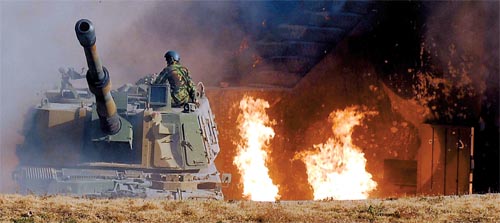N. Korea fired thermobaric bombs

South Korean K9 howitzers fired back after North Korea showered artillery shells on Yeonpyeong Island on Tuesday. Provided by the Defense Ministry
A closer look at the village and military barracks on Yeonpyeong Island the day after North Korea’s Tuesday attack revealed buildings reduced to charred blocks of cement and shattered glass.
Initial reports the day of the attack said around a dozen houses were damaged; roughly double that number are now confirmed to have been extensively damaged.
And South Korea’s military concludes the attack was meticulously planned, although much more damage would have been caused if the North’s equipment wasn’t so old and faulty. A high-ranking South Korean military official said that North Korea used thermobaric bombs, or “fuel-air bombs,” to wreak havoc on Yeonpyeong Island, the first time it has done so.
“After examining the collected rounds that fell on the island, we found them to be a variety of special weapons that can burst through concrete and [yield intense explosions],” the official said yesterday. “Upon explosion, these weapons are lethal and can destroy concrete structures with high pressure and heat.”
“It looks like North Korea used thermobaric bombs they’ve been developing for the first time,” said Representative Song Young-sun during a Defense Committee hearing at the National Assembly on Wednesday. “Regular shells explode just once, but from footage of the attack, the rounds that were fired exploded twice. This is one characteristic of thermobaric weapons.”

The South Korean military is examining around twenty North Korean shells that failed to explode and were found lodged in concrete walls and in tree branches. Eighty of the 170 shells fired managed to land on the island. Roughly 90 rounds fell into the sea.
The number of duds is expected to increase, as troops are still combing the island for shells. South Korean authorities believe the duds and the shells that failed to reach the island were the result of North Korea’s aged equipment or flawed gunpowder and detonators.
Military officials believe North Korea achieved such extensive damage on the island despite the duds and the misses because it meticulously planned the attack. It used “time-on-target” (TOT) coordination, a military tactic in which all the munitions arrive at the same time at a designated target for maximum destruction.
Minister of National Defense Kim Tae-young, who resigned yesterday, said Wednesday that North Korea used artillery guns located at the front and the rear of their bases, which means rounds were fired from locations that could not easily be detected visibly.
North Korean troops in Gaemori have also been observed since last year moving their artillery to the north, reinforcing them with concrete to defend against South Korean retaliation.
A firing drill using the TOT method was carried out by North Korea in January near the Northern Limit Line, with around 100 rounds fired, which South Korean authorities think was a dress rehearsal for Tuesday’s attack.
North Korea attacked when artillery on Yeonpyeong Island were facing southwest for firing exercises, away from North Korea, to buy more time and increase damage. Kim said it took time for the troops on the island to rotate the guns toward North Korea.
They didn’t fire randomly but specifically targeted the military base on the island, including oil storage units, and 20,000 liters of oil were released, some catching on fire. They also targeted the post office, a supermarket and municipal buildings. Those structure were formerly military buildings, so the South Korean military suspects North Korea was planning from an old map.
By Christine Kim [christine.kim@joongang.co.kr]










with the Korea JoongAng Daily
To write comments, please log in to one of the accounts.
Standards Board Policy (0/250자)